🥤 Sucking Type
Chewing and Lapping Type, Piercing and Sucking type, Rasping and Sucking, Sponging Type, Siphoning Type
The mouth part known as Asymmetrical Type?
- Haustellate mouthparts are primarily used for sucking liquids.
- This is considered as advanced type where the oral appendages get modified differently.
- Many insects of the order Hemiptera (the half-wings), feed directly on phloem sap, and make it the primary component of their diet. Phloem sap is “nutrient-rich” compared with many other plant products and generally lacking in toxins and feeding deterrents, it is consumed as the dominant or sole diet by a very restricted range of animals".
- These can be divided into two subgroups, those that possess
styletsand those that do not. Stylets are needle-like projections used to penetrate plant and animal tissue. - The modified mandibles, maxilla, and hypopharynx form the stylets and the feeding tube. After piercing solid tissue, insects use the modified mouthparts to suck liquids from the host.
- Haustellate mouthparts that lack stylets are unable to pierce tissues. Therefore these insects must rely on easily accessible food sources such as nectar at the base of a flower.
Chewing and Lapping Type (चबाना और लपेटना)
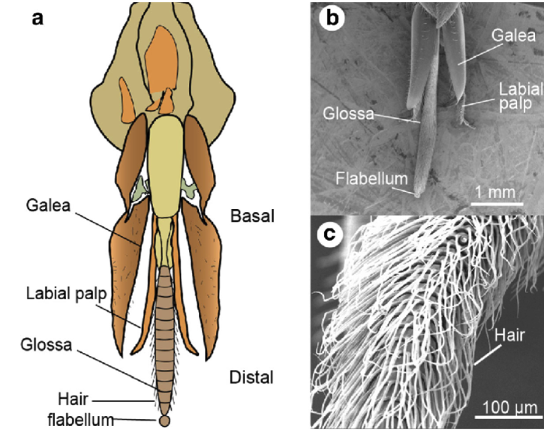
- Labrum and mandibles are as in biting and chewing type of mouth parts.
- But mandibles are blunt and not toothed.
- They are useful to crush and shape wax for comb building; ingest pollen grains and other manipulative functions.
- Maxillolabial & hypopharynx structures are modified to form sucking proboscis i.e. the lapping tongue.
- The tongue unit consists of two galea of maxillae, two labial palpi and elongated flexible hairy glossa of labium.
- The glossa terminates into a small circular spoon shaped lobe called flabellum which is useful to lick the nectar.
- The liquid food (nectar) ascends by means of capillary action into the central channel of glossae and enters into the space between paraglossae and into the mouth cavity.
- E.g. Honey bee, Bumble Bee, Wasp (adult).
Piercing and Sucking type
- They are mainly adopted for piercing the tissues & sucking either plant sap or the nectar or blood from the host.
- It is also of two types viz.

Hemipterous Type/ Bug Type
Eg. Plant Bugs feed on plant sap.
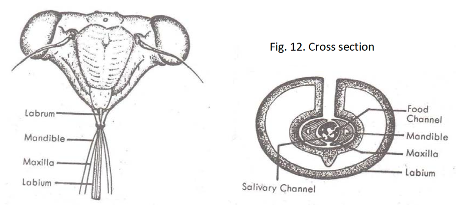

Dipterous Type/ Mosquito Type
- Eg. Female Mosquito
- Mandible found in only in female. So only female bits.
- Female pierces the skin of human beings into which it injects saliva containing an anticoagulant (to keep the blood flowing without clotting) and anaesthetic (to keep the victim unaware of the bite) and sucks up the blood.
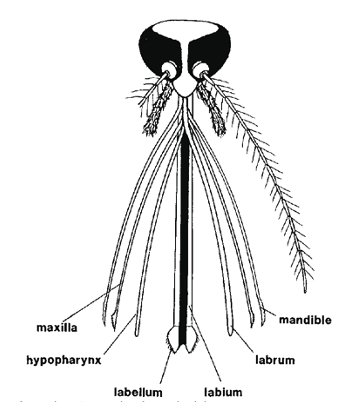
Rasping and Sucking

- Mouth cone consists of labrum, labium and maxillae. There are three stylets (2 maxillae and 1 left mandible) derived from two maxillae and left mandible.
Right mandible is absent. They are in between the biting – chewing type and piercing - sucking type.- Stylets are useful to lacerate the plant tissue and the oozing sap is sucked up by the mouth cone.
- E.g. Thrips (asymmetrical mouth parts)
- These are called
asymmetrical typesince right mandible is rudimentary.
Sponging Type

- These mouthparts are represented by
proboscisformed from the labium. - The proboscis is divided into a basal rostrum, middle haustellum, and a distal labellum.
- The labellum is a sponge like structure. It is traversed by several narrow transverse channels called pseudotrachea which converge at one point in the centre of the labellum.
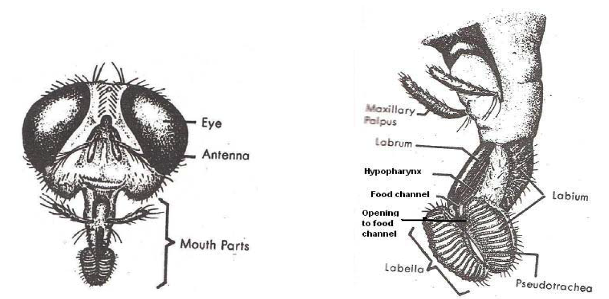
- From this point, the food enters food channel which is formed by the labrum - epipharynx and hypopharynx.
- During feeding, the proboscis is pressed over the food material.
- The pseudo trachea gets filled with the food material by the capillary action and is sucked up from the central point into the oesophagus.
- E.g. Housefly
Siphoning Type
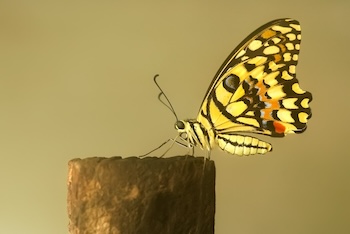
- Maxillae modified galeae. Labarum and mandibles both are rudimentary.
- E.g. Butterfly, Moth (simple sucking type)
- These are specially modified for taking nectar from the flowers. The galea of maxilla form into a slender, hollow, tubular structure which remains as an elongated coiled proboscis underneath the head during non-feeding.
- Mandibles are totally absent.
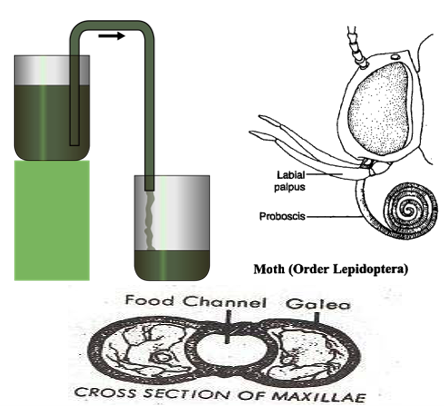
References
- Insecta - Introduction: K.N. Ragumoorithi, V. Balasurbramani & N. Natarajan
- A General Textbook of Entomology (9th edition, 1960) – A.D. Imms (Revised by Professor O.W. Richards and R.G. Davies). Butler & Tanner Ltd., Frome and London.
- The Insects- Structure and Function (4th Edition, 1998) – R.F. Chapman. Cambridge University Press
- Wikipedia
The mouth part known as Asymmetrical Type?
- Haustellate mouthparts are primarily used for sucking liquids.
- This is considered as advanced type where the oral appendages get modified differently.
- Many insects of the order Hemiptera (the half-wings), feed directly on phloem sap, and make it the primary component of their diet. Phloem sap is “nutrient-rich” compared with many other plant products and generally lacking in toxins and feeding deterrents, it is consumed as the dominant or sole diet by a very restricted range of animals".
- These can be divided into two subgroups, those that possess
styletsand those that do not. Stylets are needle-like projections used to penetrate plant and animal tissue. - The modified mandibles, maxilla, and hypopharynx form the stylets and …
Become Successful With AgriDots
Learn the essential skills for getting a seat in the Exam with
🦄 You are a pro member!
Only use this page if purchasing a gift or enterprise account
Plan
Rs
- Unlimited access to PRO courses
- Quizzes with hand-picked meme prizes
- Invite to private Discord chat
- Free Sticker emailed
Lifetime
Rs
1,499
once
- All PRO-tier benefits
- Single payment, lifetime access
- 4,200 bonus xp points
- Next Level
T-shirt shipped worldwide

Yo! You just found a 20% discount using 👉 EASTEREGG

High-quality fitted cotton shirt produced by Next Level Apparel